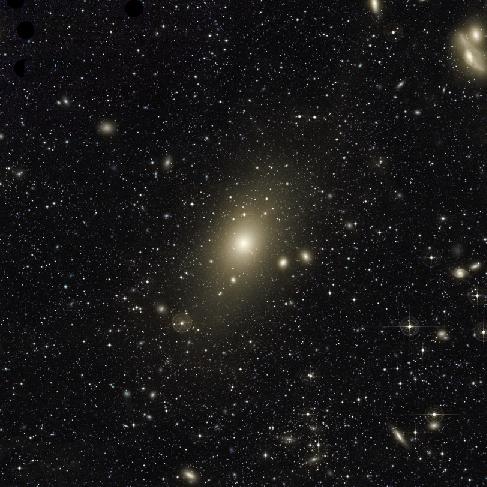12.2 The Distribution of Galaxies in Space
The region of the universe for which we have the most detailed information is, as you would expect, our own local neighbourhood. It turns out that the Milky Way Galaxy is a member of a small group of galaxies called, not too imaginatively, the Local Group. It is spread over about 3 million light-years and contains more than 54 members. There are three large spiral galaxies (our own, the Andromeda galaxy, and M33), two intermediate ellipticals, and many dwarf ellipticals and irregular galaxies.
Several new dwarf galaxies have also been found near the Andromeda galaxy. Such dwarf galaxies are difficult to find because they typically contain relatively few stars, and it is hard to distinguish them from the foreground stars in our own Milky Way.
Figure 12.8 is a rough sketch showing where the brighter members of the Local Group are located. The average of the motions of all the galaxies in the Local Group indicates that its total mass is about 4 × 1012MSun, and at least half of this mass is contained in the two giant spirals—the Andromeda galaxy and the Milky Way Galaxy. And bear in mind that a substantial amount of the mass in the Local Group is in the form of dark matter.
Local Group

Small galaxy groups like ours are hard to notice at larger distances. However, there are much more substantial groups called galaxy clusters that are easier to spot even many millions of light-years away. Such clusters are described as poor or rich depending on how many galaxies they contain. Rich clusters have thousands or even tens of thousands of galaxies, although many of the galaxies are quite faint and hard to detect.
The nearest moderately rich galaxy cluster is called the Virgo Cluster, after the constellation in which it is seen. It is about 50 million light-years away and contains thousands of members, of which a few are shown in Figure 12.9. The giant elliptical (and very active) galaxy M87 belongs to the Virgo Cluster.
Central Region of the Virgo Cluster

Giant Galaxy is Still Growing by Chris Mihos (Case Western Reserve University)/ESO, CC BY 4.0.
Attribution
“28.3 The Distribution of Galaxies in Space” from Douglas College Astronomy 1105 by Douglas College Department of Physics and Astronomy, is licensed under a Creative Commons Attribution 4.0 International License, except where otherwise noted. Adapted from Astronomy 2e.

